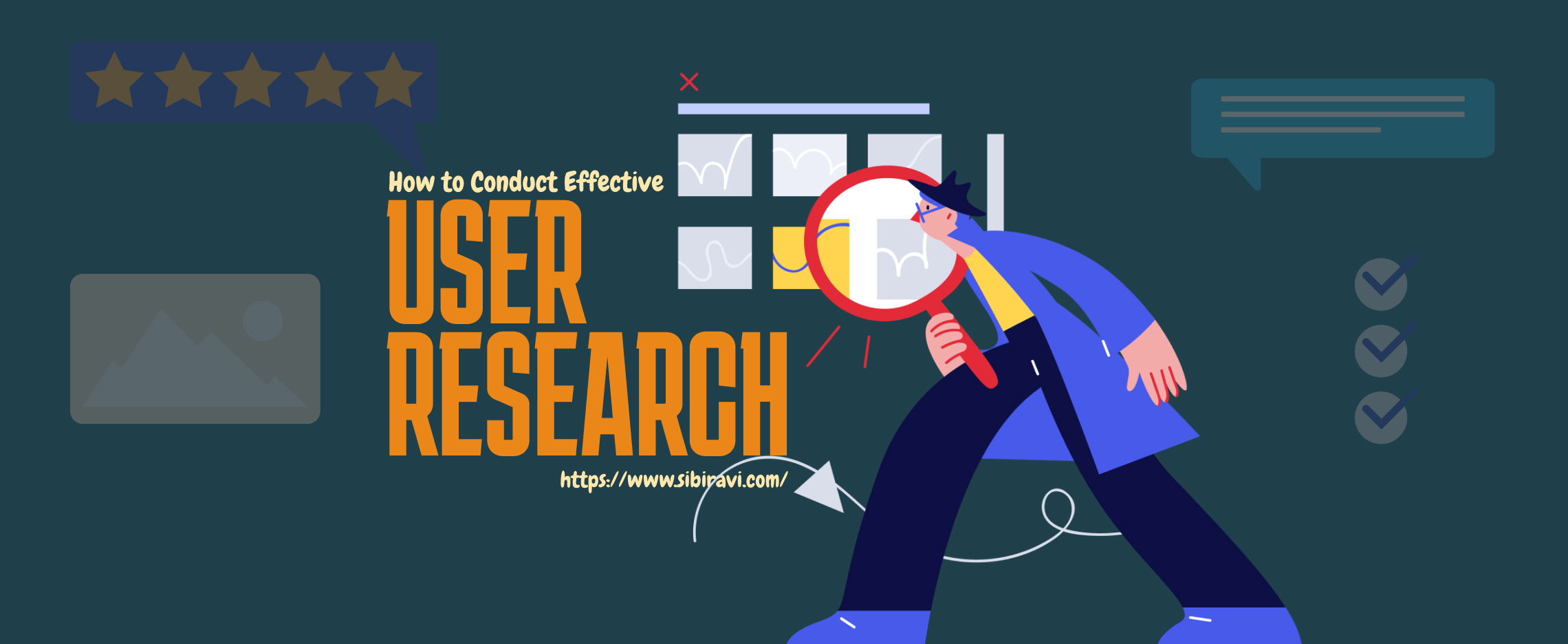
Image Credits: Author
Methods for Executing Impactful User Research in the Field of UX Design
Sibi Ravi
Published on August 30, 2024
User research is essential for establishing the groundwork of any remarkable UX design. Consider the challenge of constructing a house without a clear comprehension of the geographical context; it would indeed be quite arduous, would it not? User research enables you to comprehend the landscape before you start building, confirming that your design is not just functional but also tailored to the needs of the people who will be using it. Let’s dive into what user research is, why it’s so paramount, and how to conduct it effectively. 🏗️ 🔍
What is User Research?

Image Credits: Imam Fathoni
The process of user research is dedicated to comprehensively understanding the needs, behaviours, motivations, and difficulties faced by users. This understanding is garnered through diverse techniques such as interviews, surveys, usability assessments, and direct observation. It’s about getting to know your users on a deeper level so that you can design with their needs in mind. In essence, user research is the compass that guides the UX design process, helping you make informed decisions rather than relying on assumptions. 🧭 💡
Why Should You Conduct User Research?
Without user research, you’re essentially designing in the dark. You might have a brilliant idea, but if
it doesn’t resonate with your target audience, it’s unlikely to succeed. User research ensures that your
design is user-centred, meaning it solves real problems for real people. By understanding your users,
you can create products that are not only functional but also enjoyable to use, leading to higher
satisfaction and loyalty. 🎯
Here are a few key reasons why user research is essential:
1. Informed Decision-Making:
Research provides data that can guide your design decisions, reducing guesswork and increasing the likelihood of success.
2. Enhanced User Experience:
By understanding user pain points, you can create solutions that directly address those issues, leading to a better overall experience.
3. Improved Usability:
Research helps identify usability issues early on, allowing you to refine your design before launch.
4. Increased ROI:
A well-researched design is more likely to meet user needs, leading to higher adoption rates and better return on investment.
Stages of Conducting Effective User Research
Conducting user research is a multi-step process that requires careful planning and execution. Here’s how to do it effectively:
1. Define Your Research Goals
Before starting your research, it's important to establish what you hope to accomplish. Are you looking to analyze a certain user behaviour? Discover pain points? Assess how user-friendly a feature is defining your research goals with precision will guide you in choosing the right techniques and keeping your efforts on track.📝 🎯
2. Choose Your Research Methods
As we step into 2024, certain fonts are making waves in the design community. Here’s a look at a few trending fonts and why designers are gravitating towards them:
i. User Interviews:
One-on-one conversations that delve into the user’s experiences, motivations, and challenges.
ii. Surveys:
Structured questionnaires that gather data from a larger group of users.
iii. Usability Testing:
Monitoring how users navigate your product to pinpoint areas that may cause difficulties.
iv. Field Studies:
Observe users in their natural environment to understand how they use your product in real-world scenarios.
v. Focus Groups:
Group dialogues that yield insights into the attitudes and perceptions of users.
Choosing the right method depends on your research goals, the stage of the design process, and the
resources. 🛠️ 💬
3. Recruit Participants
Once you’ve chosen your methods, it’s time to find participants who match your target user profile. The quality of your research depends heavily on who you talk to, so it’s essential to recruit participants who accurately represent your user base. You can recruit through user panels, social media, or even by reaching out to existing customers. 👥 📊
4. Conduct the Research
With your participants lined up, it’s time to start gathering data. Whether you’re conducting interviews, sending out surveys, or running usability tests, make sure you’re creating a comfortable environment where participants feel encouraged to share their honest thoughts. Take detailed notes, record sessions (with permission), and ask open-ended questions to get rich, qualitative data. 🎙️ 🖊️
5. Analyze the Data
After collecting your data, the next step is to analyze it for patterns and insights. Look for recurring themes, common pain points, and unexpected findings. This is where you start to see the bigger picture and identify actionable insights that will inform your design decisions. Tools like affinity diagrams or thematic analysis can be helpful in organizing and interpreting the data. 📊 🔍
6. Share Your Findings
User research is most valuable when it’s shared with the broader team. Create a research report or presentation that highlights key findings, user quotes, and recommendations. Be sure to communicate how these insights can be applied to the design process. This helps ensure everyone is on the same page and that user needs are kept at the forefront of design decisions. 📢 💼
7. Iterate and Refine
User research isn’t a one-and-done process. As you move through the design process, continue to test and gather feedback. Iteration is key to refining your product and ensuring it meets user needs. Conduct follow-up research to test new features or to validate design changes. This ongoing cycle of research and iteration is what leads to truly user-centered design. 🔄 💻
Final Thoughts
User research is a critical component of UX design that ensures your products are tailored to the needs of your users. By following a structured research process—defining goals, choosing methods, recruiting participants, conducting research, analyzing data, and iterating—you can create designs that are not only functional but also delightful to use. So, the next time you embark on a design project, remember to invest in user research. Your users (and your design) will thank you! 🙌 💡